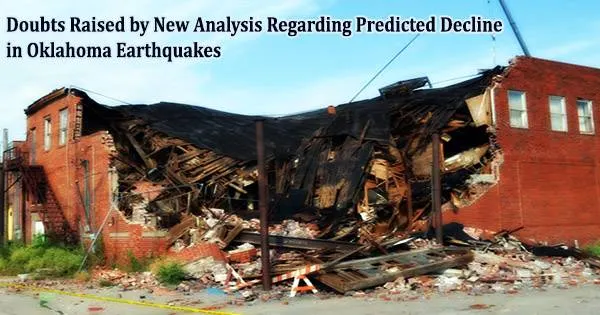Since 2009, a sharp rise in seismic activity in Oklahoma has been attributed to the deep subsurface injection of wastewater from the oil and gas industry. Due to market factors and regulatory initiatives, injection rates have lately decreased; but, according to seismologists, this has not yet appreciably decreased the probability of potentially dangerous earthquakes.
The probability of moderate earthquakes this year in the Oklahoma regions affected by the disaster is two times higher than was predicted by an earlier analysis, according to a new study headed by seismologists at UC Santa Cruz and published on August 9 in Science Advances.
The earlier study, published in November 2016, predicted that reduced wastewater injection would lead to substantially less seismic activity, with widely felt earthquakes of magnitude 3 or more decreasing significantly by the end of 2016 and approaching historic levels within a few years.
“Although they were correct in saying that small earthquakes seemed to be decreasing, the moderate earthquakes are not decreasing. The problem has not been resolved to where we can stop worrying about it,” said coauthor Emily Brodsky, professor of Earth and planetary sciences at UC Santa Cruz.
As if to underscore the new findings, central Oklahoma experienced a series of earthquakes last week, including a magnitude 4.2 temblor Wednesday night (August 2) that knocked out power in Edmond, near Oklahoma City.
State seismologist Jacob Walter, a coauthor of the new paper, said it was the fourth earthquake of magnitude 4 or greater in 2017. The rate of such earthquakes is somewhat lower than in 2016, he said, but they continue to pose a hazard.
If there’s a lag in the occurrence of induced earthquakes, we expect there might be a similar lag in any effects of a reduction in injections.
Jacob Walter
“There is still a significant seismic hazard in Oklahoma, and it’s not going to taper off as fast as the earlier paper suggested,” Walter said.
First author Thomas Goebel, a postdoctoral fellow at UC Santa Cruz, said his interest was piqued by some strong statements in the earlier paper, such as the prediction that seismicity would fall to historic levels within a few years, which he found puzzling. He noted that there were two large earthquakes in late 2016, the magnitude 5.8 Pawnee and magnitude 5.0 Cushing earthquakes, and these and other large earthquakes occurred when injection rates were relatively low.
Given the important implications regarding seismic hazards, Goebel and Brodsky decided to take a closer look at the original data and do their own analysis. For expertise on the seismic conditions in Oklahoma, they worked with Walter and a hydrogeologist with the Oklahoma Geological Survey, Kyle Murray.
Despite using the same statistical model of injection-induced seismicity as in the prior publication, the researchers’ analysis indicated a significantly greater likelihood of moderate earthquakes in 2017 (80 percent versus 37 percent). They also found no evidence suggesting that earthquake probabilities would be as low as historic values by 2025.
Walter said the Oklahoma Geological Survey is continuing to evaluate the effects of the reductions in wastewater injections. He noted that studies of injection-induced seismicity have found that there can be a substantial lag between injections and the occurrence of earthquakes.
“If there’s a lag in the occurrence of induced earthquakes, we expect there might be a similar lag in any effects of a reduction in injections,” Walter said.
















